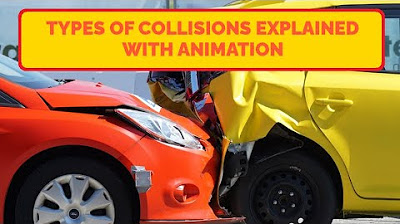Introduction to Elastic and Inelastic Collisions
Summary
TLDRIn this educational video, the presenter discusses the difference between elastic and inelastic collisions, using both theoretical explanations and practical examples. Momentum is conserved in both types of collisions, but kinetic energy is only conserved in elastic collisions. The video highlights real-world examples like billiard balls and air-hockey pucks for elastic collisions, and football tackles and train couplings for inelastic ones. The presenter also introduces the concept of perfectly inelastic collisions, where objects stick together. The lesson is interspersed with interactive student responses, making complex physics concepts more relatable and engaging.
Takeaways
- 😀 Charity Day is part of Spirit Week, where students support different non-profit organizations.
- 😀 The presenter discusses various charities including Children With Hair Loss, Alpha House, Home of New Vision, and the American Foundation for Suicide Prevention.
- 😀 Elastic collisions are defined as collisions where both momentum and kinetic energy are conserved.
- 😀 In an elastic collision, objects bounce off one another without any loss of kinetic energy.
- 😀 Inelastic collisions are those where momentum is conserved, but kinetic energy is NOT conserved.
- 😀 Kinetic energy is lost in inelastic collisions due to deformation of objects, converting energy into thermal energy.
- 😀 A perfectly inelastic collision occurs when two objects stick together after collision, and kinetic energy is not conserved.
- 😀 Examples of perfectly inelastic collisions include football tackles and railroad cars coupling together.
- 😀 A demonstration with bouncing balls shows that inelastic collisions occur when kinetic energy is not fully conserved.
- 😀 Real-world collisions are mostly inelastic, though atomic-level collisions can be elastic.
- 😀 Even in idealized cases like billiard balls, collisions are considered elastic, but in reality, they still lose some kinetic energy to thermal energy.
Q & A
What is Charity Day in the context of the script?
-Charity Day is part of Spirit Week, where students or participants represent and promote a charity of their choice.
What is Children With Hair Loss?
-Children With Hair Loss is a non-profit organization that provides human hair replacements to over 300 children annually, at no cost.
What is the main difference between elastic and inelastic collisions?
-In an elastic collision, both momentum and kinetic energy are conserved, whereas in an inelastic collision, momentum is conserved but kinetic energy is not.
Is momentum conserved in an elastic collision?
-Yes, momentum is conserved in an elastic collision, as it is in all collisions and explosions.
What is an example of an elastic collision?
-Examples of elastic collisions include collisions between billiard balls, air-hockey pucks, and atomic particles.
What sets an inelastic collision apart from an elastic collision?
-In an inelastic collision, kinetic energy is not conserved, while momentum is still conserved. The kinetic energy is transformed into other forms of energy, such as thermal energy.
Why is kinetic energy not conserved in an inelastic collision?
-Kinetic energy is not conserved in an inelastic collision because the objects deform during the collision, causing the energy to convert into thermal energy.
What is a perfectly inelastic collision?
-A perfectly inelastic collision is one where the objects stick together after colliding, such as two football players tackling each other or two railroad cars coupling together.
What happens to the kinetic energy in a perfectly inelastic collision?
-In a perfectly inelastic collision, the kinetic energy is not conserved, and the objects stick together, causing a significant amount of the kinetic energy to be converted into thermal energy or other forms of internal energy.
Why do real-world collisions, even between billiard balls, involve some loss of kinetic energy?
-Even though billiard balls are considered to undergo elastic collisions in ideal conditions, some deformation occurs during the collision, leading to a conversion of kinetic energy into thermal energy, making real-world collisions not perfectly elastic.
Outlines

This section is available to paid users only. Please upgrade to access this part.
Upgrade NowMindmap

This section is available to paid users only. Please upgrade to access this part.
Upgrade NowKeywords

This section is available to paid users only. Please upgrade to access this part.
Upgrade NowHighlights

This section is available to paid users only. Please upgrade to access this part.
Upgrade NowTranscripts

This section is available to paid users only. Please upgrade to access this part.
Upgrade Now5.0 / 5 (0 votes)





